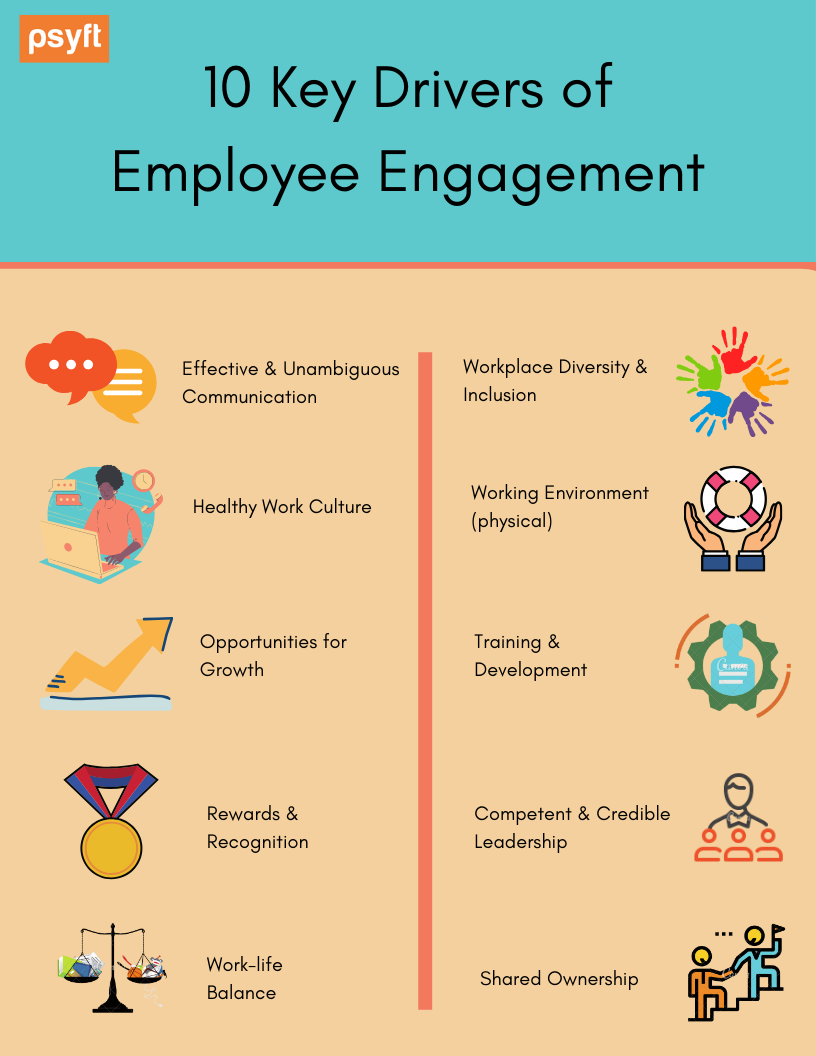Blogs
Get latest insights on what's trending in the HR world - Talent Search, Talent Assessments, Psychometrics, Employee Engagement, Appraisals & much more.

10 Key Drivers of Employee Engagement – The Ultimate Guide
26th June 2020
What makes an organization more successful and progressive than another? Among many factors like products & services, state of the art infrastructure, technology, etc. the one thing that creates a major competitive advantage – is the workforce, the people working in the organization. And when it comes to people, research has shown, time and again, that employees who are significantly engaged with their organizations, outperform those who are not engaged. In the war of competitive advantage, a truly engaged workforce is the ultimate key.
What is Employee Engagement?
As per David MacLeod, “Employee engagement is about how we create the conditions in which employees offer more of their capability and potential”.
Employee Engagement is more than just satisfaction. Engagement is the degree to which employees feel passionate about their jobs, are committed to the organization and are willing to put discretionary effort into their work. Satisfied employees are merely happy or content with their jobs and might just continue working in status-quo; whereas engaged employees are driven to do more than the bare minimum.
Employee engagement is an emotional commitment that employees have to the organization and its goals. Engaged employees genuinely care for their work and their organization.
Why is Employee Engagement Important?
1. Higher Engagement = Higher RetentionEngaged employees are more likely to stay on with their organizations. They have a strong connect with the organizations and its goals. Making sure their people are happy and well-engaged, helps companies retain their top talent and decrease their turnover rates.
2. Higher Engagement = Higher ProductivityEngaged employees are fully aligned with their roles and therefore, work harder, take initiatives and come up with innovative ways to carry out tasks, thereby boosting productivity. Highly engaged businesses witness a 17% increase in productivity*.
3. Higher Engagement = Greater ProfitabilityHighly engaged businesses result in 21% greater profitability*. When employees are happy at work, they make extra efforts to produce quality results. They also help build stronger relationships with clients and thus increase their company’s profitability.
4. Higher Engagement = Less AbsenteeismEngaged employees turn up at work and do not look for excuses to avoid doing their job. Highly engaged businesses witness a 41% reduction in absenteeism*.
5. Higher Engagement = Stronger Employer BrandEngaged employees are great endorsers as well. They are loyal to their organizations and therefore help build a strong employer brand that enjoys a competitive edge.
10 Key Drivers of Employee Engagement
Employee engagement is that factor that directly impacts any organization’s bottom-line. We bring to you 10 key drivers/ingredients that build and elevate employee engagement –
1. CommunicationThe levels of employee engagement at an organization surely rise when the organization endorses and effective and unambiguous communication channel. Open, easy and two way feedback mechanism, a clear understanding of organization’s vision and policies lifts the employee-connect. It has the potential to increase the chances of employee involvement at work, contributing to organizational and individual performance, business success and overall well - being.
2. Organization CultureOrganization Culture refers to the overall vibe, values customs, norms and quality of social behavior at work. A healthy work culture gives boosts the overall engagement levels in an organization, while a toxic work culture mars engagement and also kills productivity.
3. Opportunities for GrowthOne of the most important factors for greater employee engagement is whether employees feel that their company offers them with opportunities for professional advancement. Employees who get an opportunity to grow with their organization are far more likely to engage than those who stagnate in their roles.
4. Rewards & RecognitionWhile compensation (fair pay/salary structure) is surely an engagement booster, here we are talking about those intangible factors that also matter a lot. Rewards and Recognition act as great motivational and engagement factors at work today. If employees are acknowledged and awarded for the work they do, they will surely be more engaged and instinctively inspired to find better ways to solve a problem or even create a faster way to achieve a task.
5. Work-life BalanceIf employees are able to balance out between work and personal commitments effectively; they stay better engaged. Work-life balance impacts the overall well-being of employees. When organizations offer flexibility and help employees balance things out with their work and life, it leads them to work more efficiently and perform better. Assisting employees with their lives improves their productivity and makes them want to stay at your company and go the extra mile. Work-life balance has become the most crucial factor today, given most of the workforce across the globe is working remotely.
Companies with an engaged workforce, outperform those without an engaged workforce by 202%
6. Diversity & InclusionThere’s no doubt about the fact that workplace diversity leads to greater employee engagement. When an organization offers a diverse and inclusive work culture for its people, they feel more included, hence more engaged. Employees enjoy working in diverse teams - it keeps them at ease, generates a mutual camaraderie, boosts inter-personal relationships. Workplace diversity and inclusion fosters better team work, healthier collaborations, lesser bias and all this leads to elevated levels of employee morale and engagement.
7. Physical Working EnvironmentA healthy and safe working environment is a great employee engagement booster. When we say working environment, we mean working conditions conducive to employees working comfortably and making choices that are good for business. Companies that offer a favorable and effective work environment to employees - basic amenities & facilities, work space, safety, hygiene, etc. are likely to positively influence their willingness to stay engaged.
8. LeadershipWhen employees feel confident about the competence and credibility of their top management, theirs is sense of security among them. This becomes all the more important when organizations are going through unprecedented times (such the current COVID19 pandemic). When employees are assured that the company is being steered by capable leaders they feel more comfortable about their future and also the future of their organization.
9. Training & DevelopmentTraining and Development opportunities are among the vital factors contributing to employee engagement at any workplace. When employers provide learning & training initiatives for employees at work and continuously invest both time and money in their development, employees realize that the company is also interested in their career advancement and this has a positive impact on their performance & engagement levels.
10. OwnershipLeaders need to realize that the key to engagement is shared ownership. When employees are made part of the bigger picture - goals to be achieved, critical decisions to be made, etc they have a sense of ownership, moreover, it can become one of the best ways to build strong, sustainable and better-engaged teams. When companies celebrate business success/achievements/ important milestones together, employees feel adequately connected and committed to their companies.
Conclusion
When it comes to Return on Investment (ROI), employee engagement is critical in driving success. When employees are engaged, they are more likely to invest in the work they do which leads to a higher productivity and efficiency. Increased profitability, improved quality, reduced turnover and absenteeism, are a few among the many benefits of having an engaged workforce. Organizations should make all endeavors to focus on the key drivers of engagement and create an environment that fosters employee wellbeing.
*A Study by Gallup.
Recent Articles
- When Everyone Wants WFH - Tips To Manage An Expanding Team Of Remote Employees
- 5 Proven Strategies To Retain Your Best Talent In 2022
- Why Organizations Should Take Exit Surveys Seriously
- How To Create A Culture Of Recognition In The Workplace
- Why Manager Effectiveness Survey Is Important For A Workplace
News Center
- India Today - 7 reasons companies ask for psychometric tests
- Business World - AI - The New Secret Sauce in Psychometric Assessments
- DNA - HR Trends for 2018
- The Hindu - Psychometric Assessment a "game changer" in hiring
- Entrepreneur - 9 ways to promote actionable feedback at organisations
- Human Capital - Looking Beyond Performance Appraisals


